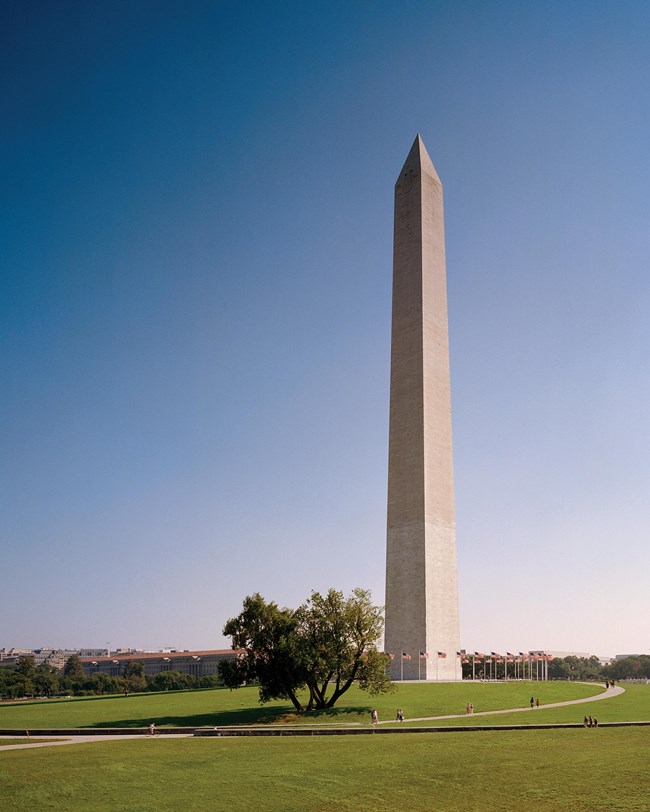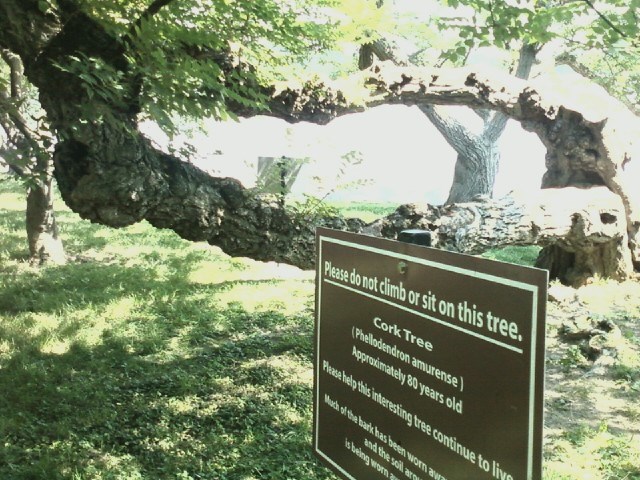Last updated: September 19, 2022
Article
Silent Sentinels of Storied Landscapes

NPS / Anthony DeYoung
Witness Tree Protection Program
Witness trees stand as silent sentinels of storied landscapes and help connect people, history, and places. They experience important events in American history and remain part of our nation's cultural legacy.
In the late 19th century, Washington became known as the "City of Trees," and that nickname endures. From the majestic elms along the National Mall and the stately oaks of Capitol Hill to the historic magnolias of the White House, and the graceful blossoms of the cherry trees, these trees not only witness history, but also serve as representatives of our nation's urban forests.
Trees were an important part of George Washington's vision for the capital city. The city design by Pierre L'Enfant called for grand avenues emanating from the U.S. Capitol and the President's House, with abundant tree groves, parks, and open space. The main avenue, similar to the Champs-Élysées in Paris, connected the Capitol with the President's House: Pennsylvania Avenue.
In 2000, the National Park Service created the Historic American Landscapes Survey (HALS) to document an aspect of human intervention on nature: historic landscapes from gardens to battlefields. In the summer of 2006, HALS initiated the Witness Tree Protection Program to identify and document historically and biologically significant trees in the greater Washington, DC area. Each of these trees has special characteristics that make it nationally significant.
Several nationally-significant trees researched by the Witness Tree Protection Program in the National Mall and surrounding area include:

NPS
Andrew Jackson magnolia trees
White House
On each side of the south portico of the White House, in 1829 President Andrew Jackson planted Magnolia trees in memory of his late wife Rachel. Magnolias were her favorite trees, so the president brought saplings from his home, the Hermitage in Tennessee, and planted them to remember her. A fixture on the White House grounds ever since, sadly, one was removed in 2017. It was replaced with a magnolia grown from a seed of the original, keeping the Jackson tradition alive. Poised, stout, and strong, they are such a presence that they are depicted on the back of the old $20 bill.
NPS
Jefferson Elm
North of the Smithsonian Freer Gallery on the National Mall
In 1935, 333 American elms were planted along the north and south edges of the Mall in four parallel rows, under the McMillan Commission Plan, an architectural plan formulated in 1902 by the Senate Park Commission. Although many of the original American elms planted during the 1930s have since died and been replaced, the Jefferson Elm, north of the Smithsonian Freer Gallery, and its fellow survivors recall the time when L'Enfant's 1791 vision for a tree-lined mall was finally realized.
The Jefferson Elm's leaves remain green through late October, while most of the neighboring elms begin losing leaves by early October. The extended period of foliation might indicate vigorous and genetically unique specimens. Throughout the 1980s and early 1990s, experiments done on trees grown from cuttings of the Jefferson Elm provided results that the tree was resistant to Dutch elm disease. It is believed that a unique genetic arrangement has led to the Jefferson Elm's resistance to Dutch elm disease and its inability to effectively reproduce via seeds. Another unique characteristic is its U-shaped branch junction, which provides a stronger means of support. Therefore, while the Jefferson Elm's primary biological significance is its resistance to Dutch elm disease, it also benefits from a superior branching structure.
Other Notable Trees:

NPS
Catalpa trees
Survey Lodge Ranger StationWhen Survey Lodge Ranger Station was completed southwest of the Washington Monument in 1889, no trees or shrubs were planted around it. By 1902, an oval road was constructed around the building and lined with trees including fir, pine, crape myrtle and several large catalpas. The catalpa trees located northwest and southeast of Survey Lodge could date from the turn of the century planting project, making them significant because of their age. Today, they serve as shade for park visitors on hot days, but they have witnessed over a century of history around the Washington Monument and Survey Lodge.

NPS
White Mulberry tree
Washington MonumentAlthough the age of the white mulberry tree located southwest of the Washington Monument has not been determined, historic photographs suggest that it could have been established naturally around 1910.
It is likely that the tree was not on the grounds before 1887-88, when the final grading occurred around the base of the Washington Monument, creating the knoll. Ornamentals like the cherry trees were planted on the grounds as early as 1886 and during the1890s deciduous trees were planted throughout the monument grounds. In 1890-91, the curvilinear road that connected 16th Street to the monument plaza was constructed. Since the tree follows the curve of the road, now a path, it could have been planted after the road was added or it could have grown there voluntarily. Mulberry trees, however, were not commonly used as street trees, so some speculate that the tree may be the only naturally occurring vegetation on the site.
It was not until the 20th century, however, that there was visual historical evidence of the mulberry tree on the grounds. An aerial photograph from 1919 shows similar vegetation near the current location of the tree. Photographs from 1923 and 1930 clearly show a grouping of trees that may have included the mulberry tree. Definitive evidence of this specific mulberry tree on the Washington Monument grounds dates from November 16, 1969, when a photograph was taken of a march against the Vietnam War on the monument grounds. Therefore, this tree also may have witnessed a number of historic events, such as the March on Washington for Jobs and Freedom on August 28, 1963, when Dr. King delivered his "I Have a Dream" speech on the Lincoln Memorial steps.
In 2019, a portion of the mulberry tree fell during a heavy rain storm. Natonal Park Service arborists were able to partially raise the fallen portion and install a prop to help the tree support its weight.

NPS
Circle of Willow Oak trees
South of the Vietnam Women's MemorialIt has been suggested that a circle of Willow Oaks was planted in the 1920's encircling a picnic area along the north side, west end of the Reflecting Pool. Its location is currently south of the Vietnam Women's Memorial. In 1921, American Forests sponsored a memorial tree planting campaign and First Lady Florence Harding planted two American elms at the 23rd Street entrance to the Lincoln Memorial grounds in honor of the signing of the armistice ending World War I. Some speculate that the circle of oaks could have been planted then, but more likely it was during the 1970's Constitution Gardens site rehabilitation. Regardless, they were there to witness the creation of Constitution Gardens in 1976 and the Vietnam Veterans Memorial progression and addition of statues from 1982 to 2004.

NPS
Cork trees
Franklin Delano Roosevelt MemorialThe area where the Franklin Delano Roosevelt Memorial is now sited was formerly a scenic road along the Tidal Basin. Many different tree varieties were planted individually or in small groves along this drive over the years. Of those, one often catches visitors' eye, these craggly, twisted trees mixed in with the cherry trees. Several Amur cork trees between room three of the Franklin Delano Roosevelt Memorial and the Tidal Basin with a sign stating the trees are 80 years old. Perhaps they witnessed the Thomas Jefferson Memorial construction across the Tidal Basin and its dedication in 1943.

NPS
Several Varieties of Trees
District of Columbia War MemorialThe District of Columbia War Memorial, dedicated in 1931, commemorates the citizens of Washington, DC, who served and died during World War I. From 1931 to 1939, dogwood, holly, magnolia, elm, pine and crabapple trees replaced the pre-memorial willow trees and were planted to honor Washington's 487 men and women who died during World War I. Today, the cultural landscape of the DC War Memorial is in good condition and illustrates a high level of integrity due to an extensive restoration effort completed in late 2011 to restore this site to its 1939 appearance.
Legacy
Like monuments and memorials that are placed on a particular landscape, trees convey a deep relationship with the events and history that surround them. Their place in that history depends on the humans that shape them, and ultimately what park visitors take with them on their journey.
You can help protect our natural landscape heritage at National Mall and Memorial Parks by educating others to refrain from climbing the trees and standing at the base of trees which compacts the soil and damages their roots.
[Editor's Note: This article originally appeared in the National Mall Times, the newspaper of the National Mall and Memorial Parks, ca. 2012. It was updated and revised for this format 10/24/2017. Author: Mike Townsend. Editors: Michael T. Kelly and Nathan King.]
